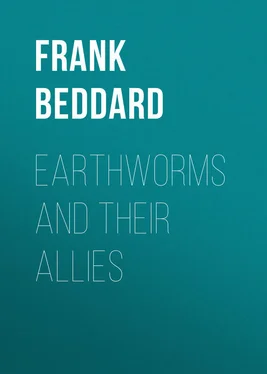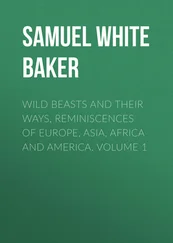Frank Beddard - Earthworms and Their Allies
Здесь есть возможность читать онлайн «Frank Beddard - Earthworms and Their Allies» — ознакомительный отрывок электронной книги совершенно бесплатно, а после прочтения отрывка купить полную версию. В некоторых случаях можно слушать аудио, скачать через торрент в формате fb2 и присутствует краткое содержание. Жанр: foreign_antique, foreign_prose, на английском языке. Описание произведения, (предисловие) а так же отзывы посетителей доступны на портале библиотеки ЛибКат.
- Название:Earthworms and Their Allies
- Автор:
- Жанр:
- Год:неизвестен
- ISBN:нет данных
- Рейтинг книги:3 / 5. Голосов: 1
-
Избранное:Добавить в избранное
- Отзывы:
-
Ваша оценка:
- 60
- 1
- 2
- 3
- 4
- 5
Earthworms and Their Allies: краткое содержание, описание и аннотация
Предлагаем к чтению аннотацию, описание, краткое содержание или предисловие (зависит от того, что написал сам автор книги «Earthworms and Their Allies»). Если вы не нашли необходимую информацию о книге — напишите в комментариях, мы постараемся отыскать её.
Earthworms and Their Allies — читать онлайн ознакомительный отрывок
Ниже представлен текст книги, разбитый по страницам. Система сохранения места последней прочитанной страницы, позволяет с удобством читать онлайн бесплатно книгу «Earthworms and Their Allies», без необходимости каждый раз заново искать на чём Вы остановились. Поставьте закладку, и сможете в любой момент перейти на страницу, на которой закончили чтение.
Интервал:
Закладка:
Frank E. Beddard
Earthworms and Their Allies
PREFACE
The importance of earthworms in questions relating to geographical distribution is so universally admitted that it seemed to me convenient to embody in a short volume the principal facts.
It became necessary in order to accomplish this task in an adequate fashion to preface the distributional facts with some anatomical and zoological data. I have reduced this section of the book to a minimum and I trust that the illustrations will enable the reader, who is not specially acquainted with the structure of these animals, to obtain an idea of their general features and variability in external character and internal anatomy. While the use of technical terms is inevitable in presenting such details, it will be found, I think, that a reference to the figures will render them intelligible.
Since this volume mainly deals with the phenomena of distribution, I have included in my survey nearly all of the usually admitted genera of worms, particularly of the terrestrial forms, which are in the light of our present knowledge the more important in considering this subject.
F. E. B. Zoological Society of London. December , 1911.CHAPTER I
STRUCTURAL AND SYSTEMATIC
The group of segmented, bristle-bearing, worms, termed Oligochaeta by zoologists, comprises what are popularly known as earthworms together with certain forms, inhabitants of ponds, lakes and rivers, which are not so well known as to have received a more distinctive name than merely 'worms.' Their next allies are apparently the leeches and – a little more remote – marine bristle-bearing worms termed Polychaeta; the three groups, together with perhaps a certain number of other forms belonging to smaller groups, constitute the Annelida which are a distinct and separate assemblage of invertebrate animals.
The most interesting features about these Oligochaetous worms are their very great anatomical variation and the facts of their distribution over the globe. Their importance as geological agents in levelling the ground was made known a long time ago by Darwin, and that aspect of earthworms has remained in much the same position as Darwin left it. We shall concern ourselves here only with the structure, habits, and range of the earthworms and their immediate allies, the aquatic Oligochaeta. These three aspects of the animals dovetail into each other more thoroughly than is the case with some other groups. This is due to the fact that they have of late years been very thoroughly studied from the anatomical and distributional side. So lately as 1889, M. Vaillant in a very comprehensive treatise was only able to enumerate 369 species, of which a large number were but incompletely differentiated, and some are no longer admitted. There are at the moment of writing perhaps 1500 species, the vast majority of which are well known owing to careful investigation. Furthermore there are but few parts of the world, and these are not of large area, from which earthworms at any rate have not been gathered. Though there can be no doubt that a very considerable number of species await discovery, it would seem that we are in possession of information which is not likely to be seriously affected by future researches.
The Anatomy of Earthworms
Although it is not contemplated to make the present volume a guide to the structure of this group of worms, it is necessary to give some little anatomical sketch of the group in order first of all to illustrate their diversity of structure, secondly to give reasons for the classification of them, and thirdly to enable the reader to realise certain structural details which it is absolutely necessary to give some account of in order to explain other matters.
It is for example impossible to attempt any account of the fitness of some of these animals for their terrestrial life and of others for an aquatic life without treating of anatomy to some extent.
I shall take one particular species as a type and indicate later the principal divergencies shown by other forms. According to the general opinion among those who have studied the Oligochaeta I take as a representative form a Megascolecid (this and the other families are dealt with seriatim on p. 14 et seq.), as this group is presumed to be the oldest, and within that group a representative of the genus Notiodrilus which is with some reason held to be the most primitive genus in the group. Finally I have no particular reason for selecting the species Notiodrilus tamajusi except that there happens to be a longer and fuller description of it than of many.
This earthworm is a native of Guatemala and is some six inches in length with a diameter of perhaps a quarter of an inch. The front part of the body is thicker than posteriorly. The body will be seen to be divided into some 218 rings by circular furrows which run right round the body. These divisions are termed segments or somites. At the head the mouth is surrounded by the first of these, and on the dorsal surface of that segment is a projection like an incomplete segment which is known as the prostomium. From the XIIIth segment to the middle of the XXth the body has a different appearance, and this region is known as the clitellum. Each of the 218 segments of the body except the first, and possibly one or two at the hinder end, is furnished with eight minute projecting bristles, the setae; these are disposed in pairs and all lie upon the ventral aspect of the worm. The movement of these by special muscles aids in locomotion.
An examination with even a hand lens shows a number of external pores which are important. Anteriorly there is the mouth which is overhung by the prostomium referred to above. At the extreme hind end – and surrounded by the last segment of the body – is the vent. Along the middle line of the back are a series of pores, one just at the very anterior edge of each segment, through which, when the worm is dried and then slightly pressed, liquid is seen to be ejected. These are called the dorsal pores and they belong one to each segment with the exception of the first seven, or – in some cases – more, segments. In front of one or other of the pair of setae which is situated most laterally, i. e. furthest from the ventral median line, is an orifice on each side in all but the first one or two segments of the body. These paired pores are the external outlets of the excretory organs frequently termed on account of their regular repetition with the segments 'segmental organs,' but more conveniently to be named nephridia. In the clitellar region and in fact on each of the segments XVII, XVIII, XIX are a pair of pores of which those on the XVIIIth segment are the least conspicuous. The large pair of pores on each of segments XVII and XIX occupy the position of the ventralmost pair of setae, which are here absent, or rather replaced by a very long curved and ornamented seta, which projects out of the orifice. These two pairs of pores are the outlets of the prostatic glands as they have been termed. The minute pair of pores on segment XVIII do not take up the position of the ventral setae; for these are present and to the inside of each pore. A groove, shaped something like a reversed 3 or the Greek letter Σ, connects the orifices of each side of the body, the middle part of the groove, where the two semicircular halves of which it is composed meet, coinciding with the minute pores on segment XVIII which are the orifices of the sperm ducts.
On segment XIV are a pair of very minute pores a little in front of the ventralmost setae and thus very near together. These are the openings of the oviducts. Finally, near to the anterior border-line of segments VIII and IX and on a line with the ventral pair of setae is a pore on each side through which the cavity of the spermathecae reaches the exterior.
Читать дальшеИнтервал:
Закладка:
Похожие книги на «Earthworms and Their Allies»
Представляем Вашему вниманию похожие книги на «Earthworms and Their Allies» списком для выбора. Мы отобрали схожую по названию и смыслу литературу в надежде предоставить читателям больше вариантов отыскать новые, интересные, ещё непрочитанные произведения.
Обсуждение, отзывы о книге «Earthworms and Their Allies» и просто собственные мнения читателей. Оставьте ваши комментарии, напишите, что Вы думаете о произведении, его смысле или главных героях. Укажите что конкретно понравилось, а что нет, и почему Вы так считаете.












